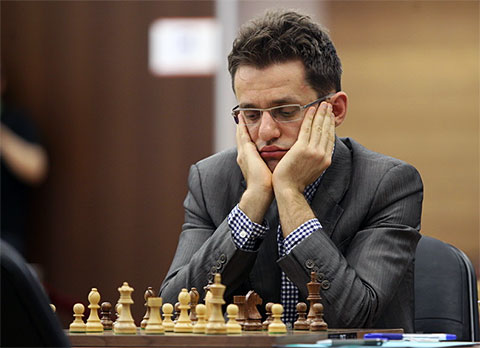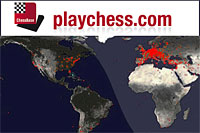The FIDE Candidates Tournament is taking place in Khanty-Mansiysk (Russia). The first round will start on Thursday, March 13 at 3 p.m. local time, the final round is on Sunday, March 30, 2014. The event is a double round robin (14 rounds). The time control is 120 minutes for the first 40 moves, 60 minutes for the next 20 and 15 minutes for the rest of the game plus an additional 30 seconds per move starting from move 61.
The tournament will determine the challenger who will face the reigning World Champion Magnus Carlsen in a title match later this year. The prize fund is 600,000 Euros (= US $832,000), the first place 135,000 and last (8th) place 25,000 Euros. |
 |
Providing Anand (happiness) for Anand fans
By Sagar Shah
Just when everyone (including myself) had written him off as being too old or lacking motivation or being distracted after becoming a father, etc. etc... what does he do? He comes to the first round of the Candidates and destroys the favourite of the tournament, Levon Aronian who is currently rated 2830 and is world No. Two.

It was no ordinary win. It was a convincing victory without any chance given to his opponent. Anand's play was so consistant that people have already started dreaming about and Anand-Carlsen match later this year! While we cannot discount that possibility, 13 rounds is a long way to go. But as of now all Vishy fans can cheer: their hero is in the sole lead, as all other games ended in a draw. Today was Vishy's day, and I would like to focus on his game.


[Event "Candidates 2014"] [Site "?"] [Date "2014.03.13"] [Round "1"] [White "Anand"] [Black "Aronian"] [Result "1-0"] [ECO "C88"] [WhiteElo "2770"] [BlackElo "2830"] [Annotator "Shah,Sagar"] [PlyCount "93"] [EventDate "2014.??.??"] 1. e4 e5 2. Nf3 Nc6 3. Bb5 a6 {It is surprising that Aronian didn't go for Nf6 here which is considered now by many as a refutation of the Ruy Lopez!} (3... Nf6 {Maybe he was afraid that Anand had come well prepared after his match against Carlsen.}) 4. Ba4 Nf6 5. O-O Be7 6. Re1 b5 7. Bb3 O-O (7... d6 {is the usual move here. The point is that it is more restrained than 0-0 because the direct d7-d5 (Marshall Gambit) is not possible . A more positional game (Chigorin Variation, Breyer Variation, etc.) ensues.} 8. c3 O-O 9. h3 Nb8 10. d4 Nbd7 {the breyer variation of Ruy Lopez}) 8. h3 {Anand plays the Anti Marshall line} (8. c3 d5 9. exd5 Nxd5 10. Nxe5 Nxe5 11. Rxe5 c6 12. d4 Bd6 13. Re1 Qh4 {leads to the very complicated Marshall Gambit.}) 8... Bb7 (8... d5 9. exd5 Nxd5 10. Nxe5 Nxe5 11. Rxe5 c6 {This variation is not as popular as the normal Marshall Gambit because White has played the more useful move h3 as opposed to c3.} 12. d3 (12. d4 {is also a good choice}) 12... Bd6 13. Re1 Qh4 14. Qf3 {White has a better positon and a very good score in this line.}) 9. d3 (9. c3 d5 10. exd5 Nxd5 11. Nxe5 Nxe5 12. Rxe5 Nf4 $17 {gives Black an almost a winning position.}) 9... d5 {Aronian has come out in excellent fighting spirit for this game. He plays some sort of Marshall Gambit line and gives the game a very interesting character.} 10. exd5 Nxd5 11. Nbd2 {Anand goes for a more restrained approach. He is not tempted by the pawn on e5} (11. Nxe5 Nxe5 12. Rxe5 {Nf4 is now no longer possible. So Black must play} Qd6 13. Re1 Rae8 $44 {when he has decent compensation for the pawn.}) 11... Qd7 $146 {Aronian introduces a novelty in a position which has been played many times before. The objective merit of the novelty is not very clear.} (11... f6 {is another way to defend the e5 pawn} 12. c4 bxc4 13. Nxc4 Kh8 14. d4 $14 {White has a pleasant position.}) (11... Nf4 {seems like the best in this position.} 12. Ne4 Na5 13. Bxf4 (13. Nxe5 $6 Nxb3 14. axb3 Nxg2 15. Kxg2 f5 $17) 13... exf4 $11) 12. Nxe5 {The move which Aronian underestimated, puts him in an inferior position.} Nxe5 13. Rxe5 Nf6 14. Re1 {Black has given up a pawn for freer development and better piece play. White is solid and usually such games peter out to a draw when White gives up his extra pawn in order to catch up in development.} Rae8 15. Nf3 {Anand plays simple and strong chess. The next idea is to develop his bishop} Bd6 (15... Bc5 {was an active possibility but is met by} 16. Be3 $14) 16. Be3 Re7 (16... c5 {is what I was thinking with the idea of maybe Bb8 and Qc7, but White can defend himself:} 17. c4 Bb8 18. cxb5 axb5 ( 18... Qc7 19. bxa6 Bxf3 20. Qxf3 Qh2+ 21. Kf1 Qh1+ 22. Ke2 $18 {gives Black absolutely nothing.}) 19. a4 {and this idea of Qc7 followed by Bf3 doesn't really work, because after Qf3 there is really no threat with Qh2 and h1.}) ( 16... Qf5 {also seems quite interesting, putting pressure on the white position.}) (16... Nd5 {but this move seemed extremely natural, didn't it?} 17. a4 (17. Bxd5 Bxd5 {means excellent compensation.}) 17... Nxe3 18. Rxe3 Rxe3 19. fxe3 c5 $44 {too gives Black a nice position.}) 17. d4 Rfe8 18. c3 h6 (18... Nd5 19. Bd2 $14) 19. Ne5 $1 {a very nice simplifying manoeuvre which gives White the double bishop advantage in the endgame.} Bxe5 20. dxe5 Rxe5 21. Qxd7 Nxd7 22. Red1 $1 {It was natural to bring other rook to d1, but here it's more important to bring the e3 bishop out of the pin.} Nf6 23. c4 {A very powerful move by Anand which prevents Nd5.} c6 (23... bxc4 24. Bxc4 Nd5 25. Bd4 Rg5 26. g3 $14 {gives White a very pleasant edge.}) 24. Rac1 (24. a4 $1 {would also be a very strong move.}) 24... R5e7 25. a4 {Constant pressure by Anand on Aronian's queenside and at the same time making use of his double bishop advantage. The bishop on b7 is so poor.} bxc4 26. Bxc4 {This would be a perfect position to ask your students: what are White's advantages! Bishop pair, less pawn islands, better piece placement. All is in his favour!} Nd5 27. Bc5 {Preserving the two bishops.} Re4 28. f3 $1 {I liked this move very much. It might not be the computer's first choice, but it gives the white king some breathing space and also brings him into the game. It's true that it weakens the e3 square. The black knight can use it but if it moves, the white rook infiltrates on the 7th rank.} R4e5 29. Kf2 $1 {This is called not fearing any ghosts. The knight can move and unleash a dicovered attack on the bishop, but it has no good discovery} Bc8 {Controlling the important d7 square.} (29... Nf4 30. Rd7 $18) (29... Nc3 30. Rxc3 Rxc5 31. Bxf7+ $18) 30. Bf1 $1 {Good controlled play. The bishop on c5 is now protected and the weaknesses on c6 and a6 are clearly being targeted.} R5e6 31. Rd3 {Once again Anand finds a way to step up the pressure. He plans to move into the b-file via b3.} Nf4 32. Rb3 Rd8 33. Be3 Nd5 34. Bd2 {with the aim of moving it to a5. Anand's play conforms to the spirit of talking to your pieces. He is keeping each and every piece active and increasing their scope with each and every move. Look he activated his king, and see his every piece bubbling with energy. This is masterly play.} Nf6 {A weak move by Levon in a bad position. Not to forget he was really running short of time.} 35. Ba5 Rde8 36. Rb6 Re5 37. Bc3 Nd5 38. Bxe5 (38. Rxc6 {was perhaps simpler.}) 38... Nxb6 39. Bd4 Nxa4 {Whenever your opponent captures a pawn with his knight on the rook file which is opposite to the colour of your bishop, you can trap it with your bishop. Here the bishop on d4 has already trapped the a4 knight!} 40. Rxc6 Rd8 {40 moves are over, but what to do if you are going to lose a piece?!} 41. Rc4 $1 $18 {It's all over, the knight is trapped. Levon tries for a few tricks, but of course Anand sees through them.} Bd7 42. b3 Bb5 43. Rb4 Nb2 44. Bxb5 axb5 45. Ke3 $1 (45. Ke2 { would have thrown away the win:} Nc4 $1) 45... Re8+ 46. Kd2 Rd8 47. Kc3 {and Levon resigned. The knight is quite prettily trapped after} (47. Kc3 Nd1+ 48. Kc2 {[%csl Rd1] A simply wonderful game by Anand who showed what class he is made up of. A game in which he upset the favourite of the tournament. Is the Madras Tiger really back? This tournament will tell. But today Anand produced a gem in which the power of two bishops will be remembered for a long time in the days to come!}) 1-0

Something has gone wrong
I must say this game of Anand reminds me of the game Rosenthal-Steinitz 1873 in which the first World Champion showed masterly use of the bishop pair. Even after 140 years coaches all around the world show that game to demonstrate the power of two bishops and how to take away advanced posts from opponent's knight. I am sure that Vishy's game too will be shown in the year 2154 to many young and budding talents! For all those who haven't seen that game, here it is:

[Event "Vienna"] [Site "Vienna"] [Date "1873.08.04"] [Round "1"] [White "Rosenthal, Samuel"] [Black "Steinitz, William"] [Result "0-1"] [ECO "C46"] [PlyCount "76"] [EventDate "1873.07.21"] [EventType "tourn"] [EventRounds "11"] [EventCountry "AUT"] [Source "ChessBase"] [SourceDate "2001.11.25"] 1. e4 e5 2. Nc3 Nc6 3. Nf3 g6 4. d4 exd4 5. Nxd4 Bg7 6. Be3 Nge7 7. Bc4 d6 8. O-O O-O 9. f4 Na5 10. Bd3 d5 11. exd5 Nxd5 12. Nxd5 Qxd5 13. c3 Rd8 14. Qc2 Nc4 15. Bxc4 Qxc4 16. Qf2 c5 17. Nf3 b6 18. Ne5 Qe6 19. Qf3 Ba6 20. Rfe1 f6 21. Ng4 h5 22. Nf2 Qf7 23. f5 g5 24. Rad1 Bb7 25. Qg3 Rd5 26. Rxd5 Qxd5 27. Rd1 Qxf5 28. Qc7 Bd5 29. b3 Re8 30. c4 Bf7 31. Bc1 Re2 32. Rf1 Qc2 33. Qg3 Qxa2 34. Qb8+ Kh7 35. Qg3 Bg6 36. h4 g4 37. Nd3 Qxb3 38. Qc7 Qxd3 0-1
Analysis by Govindaseshan Srikanth
My approach to the game of chess is different from the traditional analytical way: I look for that integrative element which always tends to elude our immediate perception when the game is approached analytically in parts, move by move. In the above context, games always offer fertile ground for indulgence, and round one of the Candidates was no different.
This to me is the crux of chess: when the conceptual thinking of a player meets with the demands of the position, then the moves, pieces and squares seem to obey the divine proportion – the golden ratio: the jewel of geometry that leaves no area untouched! Later on, we shall try to consolidate this aspect and deal with its variants, when we get sufficient material from this tournament which started ideally – ideally for Indian fans and ideally for chess lovers like me who strive to look for those vestiges!

[Event "FIDE Candidates 2014"] [Site "Khanty-Mansiysk RUS"] [Date "2014.03.13"] [Round "1.3"] [White "Anand, Viswanathan"] [Black "Aronian, Levon"] [Result "1-0"] [ECO "C88"] [WhiteElo "2770"] [BlackElo "2830"] [Annotator "Srikanth, G"] [SetUp "1"] [FEN "4r1k1/1bpn1pp1/p6p/1p2r3/8/1BP1B2P/PP3PP1/R2R2K1 b - - 0 22"] [PlyCount "50"] [EventDate "2014.03.13"] 22... Nf6 {[A key move of this game: Aronian probably was aiming at the square d5 for his knight, which in coalition with the bishop on b7 and the finely placed rooks on the open e-file would have neutralised the double bishop advantage of White. But, in order to get that square, black was made to compromise on his queen side pawn structure and demeaning the bishop on b7 to passivity]} ({Therefore, Black could have considered} 22... Bc6 {[%cal Yd7c5] (to cover the d7 square from white's rook) and then try Nc5 and let the play takes its own course.}) 23. c4 {A natural move from Anand...} c6 24. Rac1 R5e7 25. a4 {...which along with this subsequent move managed to create a lasting dent in black's pawn structure and created targets for White's bishop and rook to probe at!} bxc4 26. Bxc4 Nd5 27. Bc5 $1 {Chess tends to obey a certain cosmic indenture when played elegantly (I am careful enough to avoid the expression "perfect", which is just a myth!); and for this to happen a player has to 'let go' his constraints and the tendency of "trying to do something". In that context, this move...} Re4 28. f3 R4e5 29. Kf2 $1 {...and this...} Bc8 30. Bf1 $1 {...and this would flow! The last move paved way for the rook manoeuvre on the third rank. In chess, a player need not be and cannot be flashy always. Subtle moves, like the ones mentioned above, where one notices and notches minute vestiges and prevent it from disappearing, in itself would suffice and look exquisite.} R5e6 31. Rd3 Nf4 32. Rb3 Rd8 33. Be3 Nd5 34. Bd2 Nf6 35. Ba5 {Anand's subtle regrouping of his pieces culminating in this move decided the outcome of the game. It achieved two objectives: one to cover the squares against plausible invasion by Black's pieces, and the other to optimise the power of his double bishop and rooks and capitalise on the weak pawns on the queenside} Rde8 36. Rb6 Re5 37. Bc3 Nd5 38. Bxe5 Nxb6 39. Bd4 Nxa4 40. Rxc6 Rd8 41. Rc4 Bd7 42. b3 Bb5 43. Rb4 Nb2 44. Bxb5 axb5 45. Ke3 Re8+ 46. Kd2 Rd8 47. Kc3 {The end is beautiful when the bishop on d4 arrested the knight on a4 geometrically - even when it managed to reach d1, it still was under the spell of this bishop!} 1-0
 |
About the author
Govindaseshan Srikanth is a native of Chennai, with Tamil as his mother tongue and English as his favourite language of expression. He was a contemporary of Vishy Anand during their teens and early 20s days at the Tal Chess Club at the Soviet Cultural Centre, Chennai – a landmark formative period for Vishy, as any chess enthusiast would know.
A keen reader of varied subjects as philosophy, science, literature, neurology and Hindu spiritualism, Srikanth – Sri to his friends – is a connoisseur of Karnataka Samgita or Indian Carnatic music, one of the richest and most ancient classic music forms in the world. One more addition to the ever expanding number of Indian chess writers, as he aims to take up chess writing as a serious activity in future!
|
Pictures from official site






























